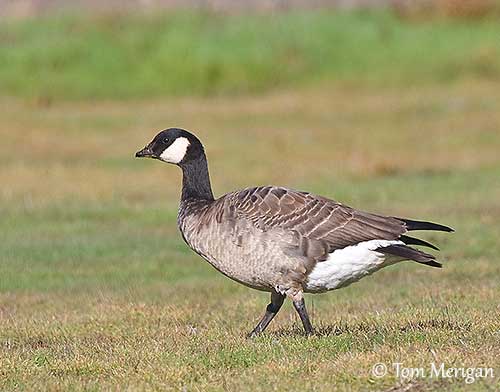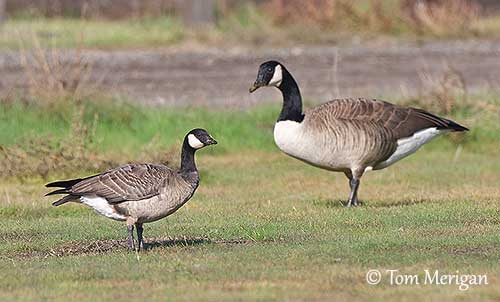
Fr: Bernache de Hutchins
Ang: Cackling Goose
All: Zwergkanadagans
Esp: Barnacla canadiense chica
Ita: Oca canadese di Hutchins
Nd: Kleine Canadese Gans
Sd: dvärgkanadagås
Photographers:
John Anderson
John Anderson Photo Galleries
Tom Grey
Tom Grey's Bird Pictures & Tom Grey's Bird Pictures 2
Tom Merigan
Tom Merigan’s Photo Galleries
William Price
PBase-tereksandpiper & Flickr William Price
Nicole Bouglouan
Photographic ramble & My pictures on IBC
Text by Nicole Bouglouan
Sources:
HANDBOOK OF THE BIRDS OF THE WORLD vol 1 by Josep del Hoyo-Andrew Elliot-Jordi Sargatal - Lynx Edicions - ISBN: 8487334105
GUIDE DES CANARDS, DES OIES ET DES CYGNES – de Steve Madge - Delachaux et Niestlé - ISBN: 2603013769
Tennessee Wildlife Resources Agency
All About Birds (Cornell Lab of Ornithology)
The Birds of North America online
Bird Web (Seattle Audubon Society)
What Bird-The ultimate Bird Guide (Mitchell Waite)
Wikipedia, the free encyclopaedia
Cackling Goose
Branta hutchinsii
Anseriformes Order – Anatidae Family
INTRODUCTION:
The Cackling Goose was formerly considered to be the same species or a subspecies of the Canada Goose, but it is now a full species since July 2004, named Cackling Goose.
Five subspecies are recognized, with one extinct (B.h. asiatica) from persecution by humans and Arctic foxes.
The Cackling Goose is migratory. It breeds in N Canada and Alaska, and also in Aleutian Islands. It winters in W, SW and S USA and Mexico, depending on the subspecies.
They feed on plant material both in water and on the ground, and also take some insects, molluscs and crustaceans. They nest in tundra habitats, usually in elevated areas near water.
The Cackling Goose is vulnerable to hunting pressure and predation by Arctic fox, but the population is suspected to be increasing and has increased its range. Currently, the species is not globally threatened.
DESCRIPTION OF THE BIRD:
Biometrics:
Length: 55-75 cm
Weight: B.h. hutchinsii: 1650-2380 g
Weight: B.h. minima: 1095-1890 g
The Cackling Goose is really the small version of the Canada Goose. Both geese have black head and neck, with a white patch from chin to ear-coverts forming a contrasting “chinstrap”.

Cackling Goose and
The upperparts are grey-brown and finely barred whitish to pale buff. The tail is black with a white band on the rump, well visible in flight.
The underparts are grey-brown and finely vermiculated whitish. Breast and flanks are paler, whereas belly and vent are white.
The small bill, legs and webbed feet are black. The eyes are dark brown.
Male and female have similar plumage, but the female is usually smaller than male.
The juvenile is duller. The white cheeks are tinged brown. Breast and flanks are mostly mottled rather than barred. It gets the adult plumage in the second year, but it is still duller with shorter flight-feathers.
SUBSPECIES AND RANGE:
The Cackling Goose has four subspecies (B.h. asiatica is extinct).
B.h. leucopareia breeds in Aleutian Island and Semidi Islands. It winters in W USA (California). Wintering birds, probably from reintroduced geese in the Kuril Islands, are often reported in Japan.
This race shows conspicuous white ring at neck base.
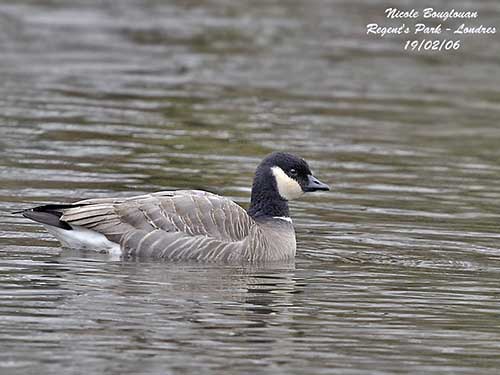
B.h. minima breeds in coastal W Alaska, from Pastol Bay S to Kuskokwim Bay. It winters in coastal W USA from Oregon S to California.
This race is the smallest, with duck-like proportions but with relatively long legs and wings, and it has short neck and very small bill. It is also one of the darkest races.
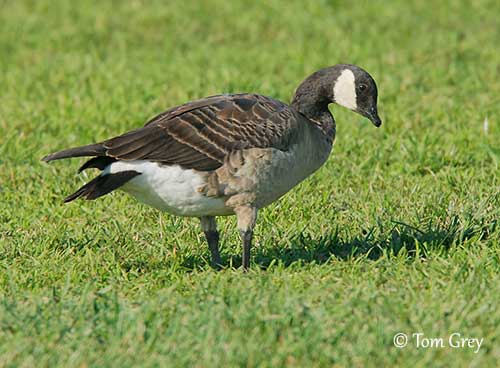
B.h. taverneri breeds in Alaska Peninsula E to Mackenzie Delta. It winters in SW USA S to W coast of Mexico.
This race shows intermediate features with other races.
B.h. hutchinsii (described above) breeds from Mackenzie Delta E throughout NC Canada. It is rare in Greenland. It winters in S USA (Texas) and Mexico.
This race is the smallest of the pale forms and it is one of the palest races. It appears small, with short bill and square-looking head.
HABITAT:
The Cackling Goose breeds in various tundra habitats in W Alaska and NC Canada, and on barren uplands on Aleutian Islands, but always near water.
It winters on inland lakes, marshes and rivers, also in coastal areas such as salt marshes, bays and tidal flats, and in brackish ponds. During winter, they often forage in open prairies, pastures and cultivated fields, and sometimes in grassy urban parks close to water.
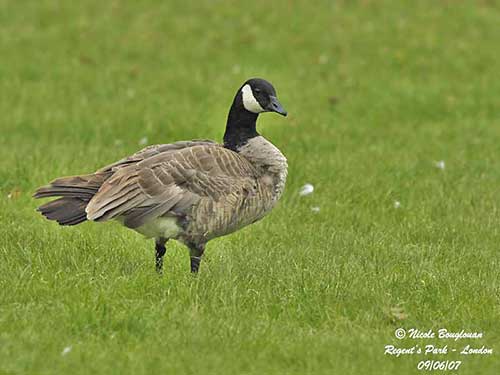
CALLS AND SONGS: SOUNDS BY XENO-CANTO
The Cackling Goose produces a honking, high-pitched cackling giving the bird its name. They are usually noisy, especially in flight.
BEHAVIOUR IN THE WILD:
The Cackling Goose feeds on plant material including numerous plant species. Its diet contains stems and shoots of grasses, sedges and aquatic plants. It also consumes insects, molluscs and crustaceans. It takes the waste grains left in cultivated fields, including wheat, alfalfa and barley.
It forages on land by walking and grazing, but it also feeds in water in which it submerges both head and neck to reach the plants.
They are usually seen in flocks. They often sleep on water, standing on one or both legs and forming rafts.
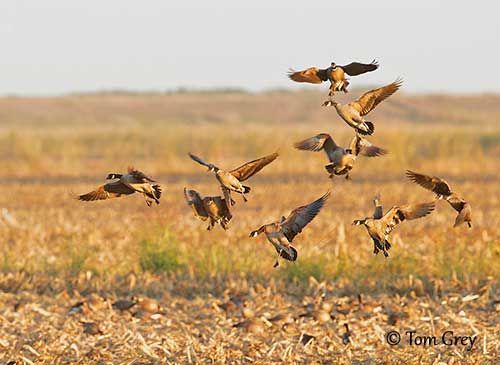
The Cackling Goose is monogamous with long-term pair-bonds. They often mate for life. They may nest in single pairs or in colonies, depending on the location. Both mates maintain and defend the territory by aggressive behaviour and fights against intruders.
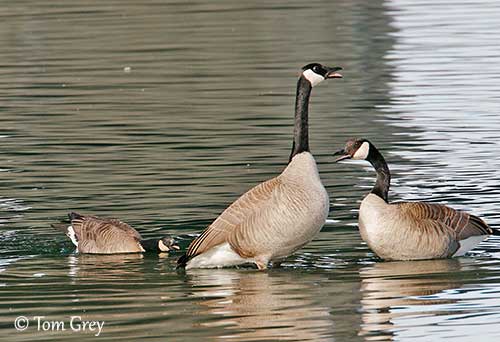
B.h. leucopareia and
The Cackling Goose is migratory, moving from the northern breeding grounds S to California, W coast of Mexico, Mexico and Texas. Numerous vagrants are reported in the four races.
The flight is powerful, with strong, deep wingbeats. They usually fly in V formation during the migration, between 300 and 1000 metres above the ground.
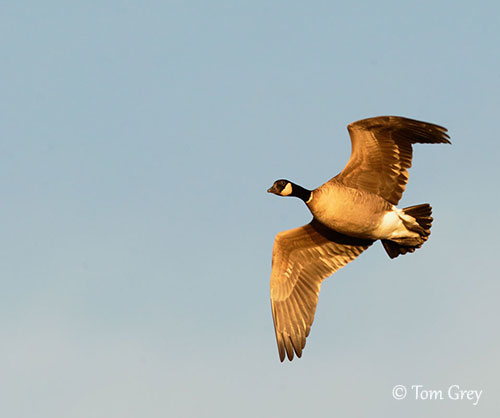
REPRODUCTION OF THIS SPECIES:
The breeding season is concentrated in spring (April-June) with variations according to the range. The Cackling Goose is monogamous and nests in single pairs or in colonies.
The female chooses the nest-site. This species usually nests near water (pond or stream) on open tundra, but sometimes in trees in parts of Alaska, or on cliff ledges in Aleutian Islands and N Alaska. In this case, they may sometimes nest colonially. The laying starts very soon after the beginning of nest building.
The female builds a shallow scrape with plant material found near the nest-site, such as sticks, grass, weeds and moss. The depression is lined with down feathers.
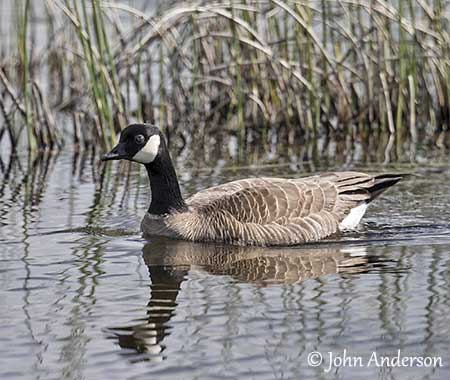
She lays 4-6 creamy-white eggs, soon becoming nest-stained. She incubates alone during 25-27 days, while the male remains in the vicinity of the nest and guards the female.
The chicks leave the nest 1-2 days after hatching. Both parents rear them, although the young are able to feed themselves from the start. They usually fly 6-7 weeks after hatching.
The young leave the breeding range with their parents. They may remain in family group during the first winter.
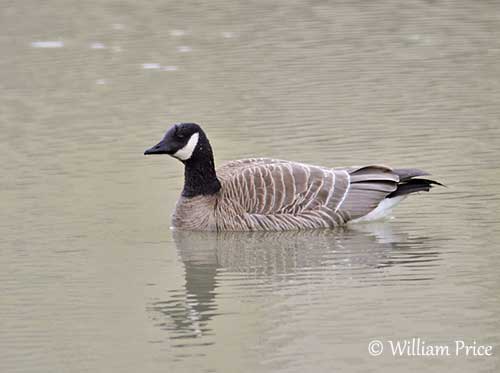
PROTECTION / THREATS / STATUS:
The Cackling Goose is vulnerable to hunting pressure in both US and Canada during the migration. They are affected by lead poisoning in hunting areas, and by pesticides and other toxins. Some decline was also caused by habitat loss in the late 19th and early 20th.
But thanks to preservation programs, improved game laws and restoration of the habitat, the populations have well recovered in most of the range;
The global population was estimated to number 920,000/1,400,000 individuals in 2006. Some populations are decreasing, but others are stable or increasing.
The race B.h. minima suffered important decrease in the 1960s and 1980s, caused by excessive hunting, but the numbers increased during the winter 2000/2001, with a population estimated at more than the double of the population in 1990.
The Cackling Goose, both adults and young, suffer predation by Golden Eagle and Bald Eagle in North America, while Arctic foxes, American minks, Bald Eagle and Glaucous Gull take large numbers of juveniles.
But the species is not considered globally threatened, and the Cackling Goose is currently evaluated as Least Concern.
